Variation Patterns of the ENSO’s Effects on Dust Activity in North Africa, Arabian Peninsula, and Central Asia of the Dust Belt
Abstract
:1. Introduction
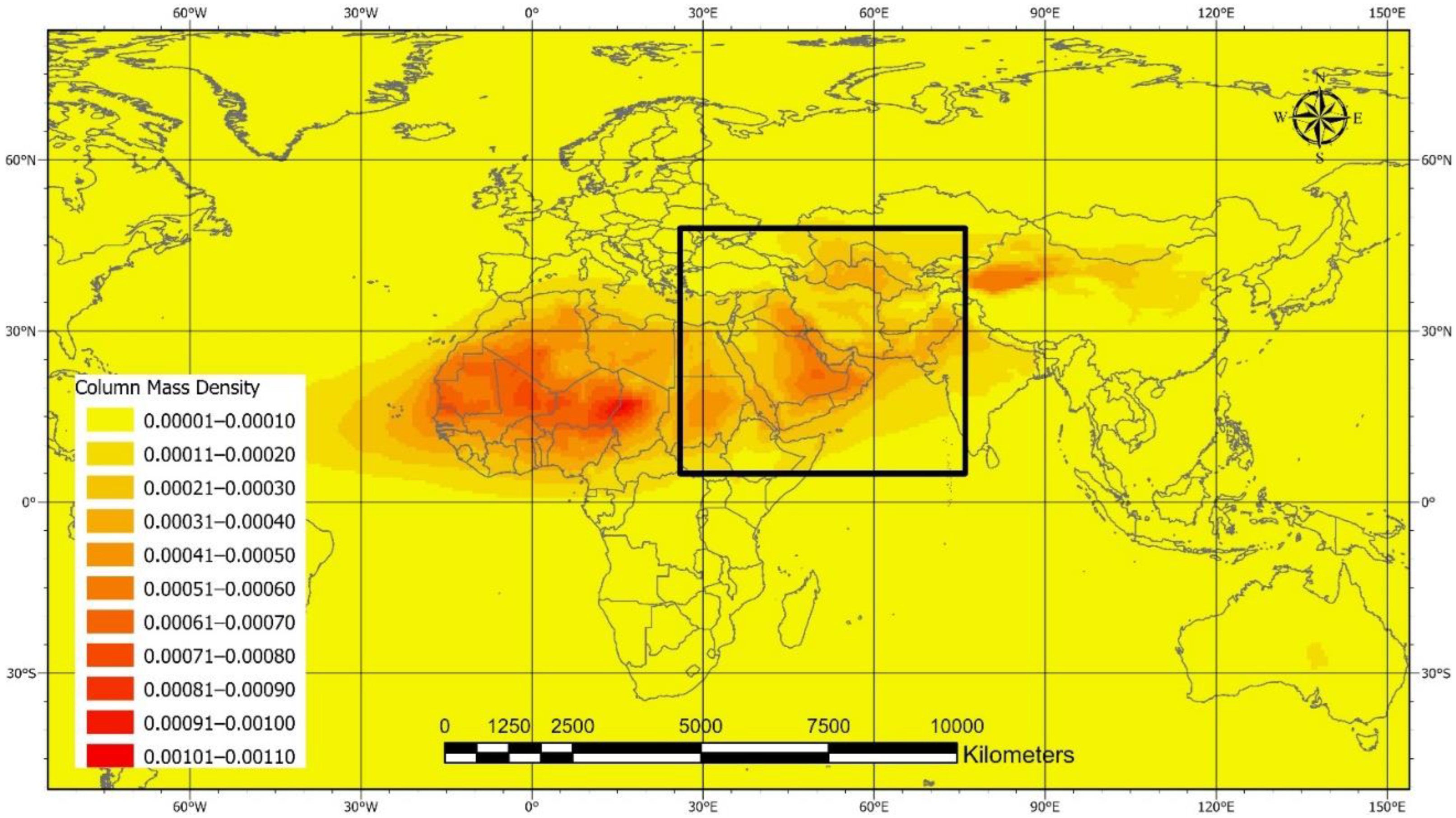
2. Data and Methods
2.1. Study Region
2.2. Data and Methods
3. Results
3.1. Seasonality of Dust Activities in Subregions
3.2. Intensities of Dust Activity during the EN, LN, and Normal Events
3.3. Correlations between ENSO and Dust Activity in Different Times of the Year
3.4. Mechanisms of the ENSO-Dust Linkages in Different Subregions
3.4.1. Precipitation and Humidity
3.4.2. Wind
3.4.3. Vegetation and Soil Moisture
3.4.4. Combined Effects of Multiple Factors on Dust Activity
4. Discussion
4.1. Spatial and Temporal Patterns of ENSO’s Effects in the “Dust Belt”
4.2. Uncertainties in the Relationship between ENSO and Dust Activity
4.3. Potential Linkages among the Subregions
5. Conclusions
Author Contributions
Funding
Data Availability Statement
Acknowledgments
Conflicts of Interest
References
- Lau, K.-M.; Kim, K.-M. Observational relationships between aerosol and Asian monsoon rainfall, and circulation. Geophys. Res. Lett. 2006, 33, L21810. [Google Scholar] [CrossRef]
- Liu, X.; Xie, X.; Yin, Z.-Y.; Liu, C.; Gettelman, A. A modeling study of the effects of aerosols on clouds and precipitation over East Asia. Theor. Appl. Climatol. 2011, 106, 343–354. [Google Scholar] [CrossRef]
- Li, Z.; Lau, W.K.-M.; Ramanathan, V.; Wu, G.; Ding, Y.; Manoj, M.G.; Liu, J.; Qian, Y.; Li, J.; Zhou, T.; et al. Aerosol and monsoon climate interactions over Asia. Rev. Geophys. 2016, 54, 866–929. [Google Scholar] [CrossRef]
- Levin, Z.; Ganor, E.; Gladstein, V. The effects of desert particles coated with sulfate on rain formation in the Eastern Mediterranean. J. Appl. Meteorol. Climatol. 1996, 35, 1511–1523. [Google Scholar] [CrossRef]
- Creamean, J.M.; Suski, K.J.; Rosenfeld, D.; Cazorla, A.; DeMott, P.J.; Sullivan, R.C.; White, A.B.; Ralph, F.M.; Minnis, P.; Comstock, J.M.; et al. Dust and biological aerosols from the Sahara and Asia influence precipitation in the western U.S. Science 2013, 339, 1572–1578. [Google Scholar] [CrossRef] [Green Version]
- Intergovernmental Panel on Climate Change (IPCC). Sixth Assessment Report: Climate Change 2021: The Physical Science Basis; Chapter 6: Short-Lived Climate Forcers; Working Group 1; IPCC: Geneva, Switzerland, 2021; Available online: https://www.ipcc.ch/report/ar6/wg1/ (accessed on 21 August 2022).
- Falkowski, P.G.; Barber, R.T.; Smetacek, V. Biogeochemical controls and feedbacks on ocean primary production. Science 1998, 281, 200–206. [Google Scholar] [CrossRef] [Green Version]
- Rizzolo, J.A.; Barbosa, C.G.G.; Borillo, G.C.; Godoi, A.F.L.; Souza, R.A.F.; Andreoli, R.V.; Manzi, A.O.; Sá, M.O.; Alves, E.G.; Pöhlker, C.; et al. Soluble iron nutrients in Saharan dust over the central Amazon rainforest. Atmos. Chem. Phys. 2017, 17, 2673–2687. [Google Scholar] [CrossRef] [Green Version]
- Prospero, J.M. Long-term measurements of the transport of African mineral dust to the southeastern United States: Implications for regional air quality. J. Geophys. Res. Atmos. 1999, 104, 15917–15927. [Google Scholar] [CrossRef] [Green Version]
- Taylor, D.A. Dust in the wind. Environ. Health Perspect. 2002, 110, 80–87. [Google Scholar] [CrossRef] [PubMed]
- Li, X.; Liu, X.; Yin, Z.-Y. The impacts of Taklimakan dust events on Chinese urban air quality in 2015. Atmosphere 2018, 9, 281. [Google Scholar] [CrossRef]
- Kotsyfakis, M.; Zarogiannis, S.G.; Patelarou, E. The health impact of Saharan dust exposure. Int. J. Occup. Med. Environ. Health 2019, 32, 749–760. [Google Scholar] [CrossRef] [PubMed]
- Prospero, J.M.; Ginoux, P.; Torres, O.; Nicolson, S.E.; Gill, T.E. Environmental characterization of global sources of atmospheric soil dust identified with the Nimbus 7 Total Ozone Mapping Spectrometer (TOMS) absorbing aerosol product. Rev. Geophys. 2002, 40, 2-1–2-31. [Google Scholar] [CrossRef]
- Washington, R.; Todd, M.; Middleton, N.J.; Goudie, A.S. Dust-storm source areas determined by the total ozone monitoring spectrometer and surface observations. Ann. Assoc. Am. Geogr. 2003, 93, 297–313. [Google Scholar] [CrossRef]
- Trenberth, K.E. The definition of El Niño. Bull. Am. Meteorol. Soc. 1997, 78, 2771–2778. [Google Scholar] [CrossRef]
- Alexander, M.A.; Blade, I.; Newman, M.; Lanzante, J.R.; Lau, N.-C.; Scott, J.D. The Atmospheric Bridge: The Influence of ENSO teleconnections on air–sea interaction over the global oceans. J. Clim. 2002, 15, 2205–2231. [Google Scholar] [CrossRef]
- Mariotti, A. How ENSO impacts precipitation in southwest central Asia. Geophys. Res. Lett. 2007, 34, L16706. [Google Scholar] [CrossRef]
- Babu, C.A.; Jayakrishnan, P.R.; Varikoden, H. Characteristics of precipitation pattern in the Arabian Peninsula and its variability associated with ENSO. Arab. J. Geosci. 2016, 9, 186. [Google Scholar] [CrossRef]
- Prospero, J.M.; Nees, R.T. Impact of the North African drought and El Niño on mineral dust in the Barbados trade winds. Nature 1986, 320, 735–738. [Google Scholar] [CrossRef]
- Barlow, M.; Cullen, H.; Lyon, B. Drought in central and southwest Asia: La Niña, the warm pool, and Indian Ocean precipitation. J. Clim. 2002, 15, 697–700. [Google Scholar] [CrossRef]
- Yin, Z.-Y.; Wang, H.; Liu, X. A comparative study on precipitation climatology and interannual variability in the lower mid-latitude East Asia and Central Asia. J. Clim. 2014, 27, 7830–7848. [Google Scholar] [CrossRef]
- Gong, S.L.; Zhang, X.Y.; Zhao, T.L.; Zhang, X.B.; Barrie, L.A.; Mckendry, I.G.; Zhao, C.S. A simulated climatology of Asian dust aerosol and its trans-Pacific transport. Part II: Interannual variability and climate connections. J. Clim. 2006, 19, 104–122. [Google Scholar] [CrossRef]
- Huang, Y.; Liu, X.; Yin, Z.-Y.; An, Z. Global impact of ENSO on dust activities with emphasis on the key region from the Arabian Peninsula to Central Asia. J. Geophys. Res. Atmos. 2021, 126, e2020JD034068. [Google Scholar] [CrossRef]
- Li, J.; Garshick, E.; Huang, S.; Koutrakis, P. Impacts of El Nino-Southern Oscillation on surface dust levels across the world during 1982–2019. Sci. Total Environ. 2021, 769, 144566. [Google Scholar] [CrossRef] [PubMed]
- Rezazadeh, M.; Irannejad, P.; Shao, Y. Climatology of the Middle East dust events. Aeolian Res. 2013, 10, 103–109. [Google Scholar] [CrossRef]
- Alizadeh-Choobari, O.; Ghafarian, P.; Owlad, E. Temporal variations in the frequency and concentration of dust events over Iran based on surface observations. Int. J. Climatol. 2016, 36, 2050–2062. [Google Scholar] [CrossRef]
- Rashki, A.; Kaskaoutis, D.G.; Sepehr, A. Statistical evaluation of the dust events at selected stations in Southwest Asia: From the Caspian Sea to the Arabian Sea. CATENA 2018, 165, 590–603. [Google Scholar] [CrossRef]
- Hamidi, M.; Kavianpour, M.R.; Shao, Y. Synoptic analysis of dust storms in the Middle East. Asia-Pac. J. Atmos. Sci. 2013, 49, 279–286. [Google Scholar] [CrossRef]
- Namdari, S.; Karimi, N.; Sorooshian, A.; Mohammadi, G.H.; Sehatkashani, S. Impacts of climate and synoptic fluctuations on dust storm activity over the Middle East. Atmos. Environ. 2018, 173, 265–276. [Google Scholar] [CrossRef]
- Yu, Y.; Notaro, M.; Liu, Z.; Wang, F.; Alkolibi, F.; Fadda, E.; Bakhrjy, F. Climatic controls on the interannual to decadal variability in Saudi Arabian dust activity: Toward the development of a seasonal dust prediction model. J. Geophys. Res. Atmos. 2015, 120, 1739–1758. [Google Scholar] [CrossRef]
- Zheng, Y.; Zhao, T.; Che, H.; Liu, Y.; Han, Y.; Liu, C.; Xiong, J.; Liu, J.; Zhou, Y. A 20-year simulated climatology of global dust aerosol deposition. Sci. Total Environ. 2016, 557–558, 861–868. [Google Scholar] [CrossRef]
- Csavina, J.; Field, J.; Félix, O.; Corral-Avitia, A.Y.; Sáez, A.E.; Betterton, E.A. Effect of wind speed and relative humidity on atmospheric dust concentrations in semi-arid climates. Sci. Total Environ. 2014, 487, 82–90. [Google Scholar] [CrossRef] [PubMed] [Green Version]
- Neuman, C.M.; Sanderson, S. Humidity control of particle emissions in aeolian systems. J. Geophys. Res. Earth Sur. 2008, 113, F02S14. [Google Scholar] [CrossRef] [Green Version]
- McTainsh, G.H.; Hynch, A.W.; Tews, E.K. Climatic controls upon dust storm occurrence in eastern Australia. J. Arid Environ. 1998, 39, 457–466. [Google Scholar] [CrossRef]
- Nielsen, J.W.; Dole, R.M. A Survey of Extratropical Cyclone Characteristics during GALE. Mon. Weather Rev. 1992, 120, 1156–1168. [Google Scholar] [CrossRef]
- Littmann, T. Dust storm frequency in Asia: Climatic control and variability. Int. J. Climatol. 1991, 11, 393–412. [Google Scholar] [CrossRef]
- Knippertz, P.; Todd, M.C. Mineral dust aerosols over the Sahara: Meteorological controls on emission and transport and implications for modeling. Rev. Geophys. 2012, 50, RG1007. [Google Scholar] [CrossRef]
- Labban, A.H.; Butt, M.J. Analysis of sand and dust storm events over Saudi Arabia in relation with meteorological parameters and ENSO. Arab. J. Geosci. 2021, 14, 22. [Google Scholar] [CrossRef]
- Rao, P.G.; Hatwar, H.R.; Al-Sulaiti, M.H.; Al-Mulla, A.H. Summer shamals over the Arabian Gulf. Weather 2003, 58, 471–478. [Google Scholar] [CrossRef]
- Kaskaoutis, D.G.; Rashki, A.; Houssos, E.E.; Mofidi, A.; Goto, D.; Bartzokas, A.; Francois, P.; Legrand, M. Meteorological aspects associated with dust storms in the Sistan region, southeastern Iran. Clim. Dyn. 2014, 45, 407–424. [Google Scholar] [CrossRef]
- Ackerman, S.A.; Cox, S.K. Surface weather observations of atmospheric dust over the southwest summer monsoon region. Meteorol. Atmos. Phys. 1989, 41, 19–34. [Google Scholar] [CrossRef]
- Xi, X.; Sokolik, I.N. Dust interannual variability and trend in Central Asia from 2000 to 2014 and their climatic linkages. J. Geophys. Res. Atmos. 2016, 120, 12175–12197. [Google Scholar] [CrossRef] [Green Version]
- Hamzeh, N.H.; Karami, S.; Opp, C.; Fattahi, E.; Jean-Francois, V. Spatial and temporal variability in dust storms in the Middle East, 2002–2018: Three case studies in July 2009. Arab. J. Geosci. 2021, 14, 538. [Google Scholar] [CrossRef]
- Namdari, S.; Zghair Alnasrawi, A.I.; Ghorbanzadeh, O.; Sorooshian, A.; Kamran, K.V.; Ghamisi, P. Time series of remote sensing data for interaction analysis of the vegetation coverage and dust activity in the Middle East. Remote Sens. 2022, 14, 2963. [Google Scholar] [CrossRef]
- Mackinnon, D.J.; Elder, D.F.; Helm, P.J.; Tuesink, M.F.; Nist, C.A. A method of evaluating effects of antecedent precipitation on duststorms and its application to Yuma, Arizona, 1981–1988. Clim. Chang. 1990, 17, 331–360. [Google Scholar] [CrossRef]
- Gillette, D.A. Threshold friction velocities for dust production for agricultural soils. J. Geophys. Res. Atmos. 1988, 93, 12645–12662. [Google Scholar] [CrossRef] [Green Version]
- Gillette, D.A.; Passi, R. Modeling dust emission caused by wind erosion. J. Geophys. Res. Atmos. 1988, 93, 14233–14242. [Google Scholar] [CrossRef] [Green Version]
- Kok, J.F.; Parteli, E.J.R.; Michaels, T.I.; Karam, D.B. The physics of wind-blown sand and dust. Rep. Prog. Phys. 2012, 75, 106901. [Google Scholar] [CrossRef] [Green Version]
- Mahowald, M.; Albani, S.; Kok, J.F.; Engelstaeder, S.; Scanza, R.; Ward, D.S.; Flanner, M.G. The size distribution of desert dust aerosols and its impact on the Earth system. Aeolian Res. 2014, 15, 53–71. [Google Scholar] [CrossRef] [Green Version]
- Duce, R.A. Sources, distributions, and fluxes of mineral aerosols and their relationship to climate. In Aerosol Forcing of Climate, Report of the Dahlem Workshop on Aerosol Forcing of Climate, Berlin 1994, April 24–29; Charlson, R.J., Heintzenberg, J., Eds.; Wiley: New York, NY, USA, 1995; pp. 43–72. [Google Scholar]
- Shao, Y.; Leslie, L.M. Wind erosion prediction over the Australian continent. J. Geophys. Res. Atmos. 1997, 102, 30091–30105. [Google Scholar] [CrossRef] [Green Version]
- Wasson, R.J.; Nanninga, P.M. Estimating wind transport of sand on vegetated surfaces. Earth Surf. Proc. Landf. 1986, 11, 505–514. [Google Scholar] [CrossRef]
- Wolfe, S.A.; Nickling, W.G. The protective role of sparse vegetation in wind erosion. Prog. Phys. Geog. 1993, 17, 50–68. [Google Scholar] [CrossRef]
- Tucker, C.J.; Vanpraet, C.L.; Sharman, M.J.; Van Ittersum, G. Satellite remote sensing of total herbaceous biomass production in the Senegalese Sahel: 1980–1984. Remote Sens. Environ. 1985, 17, 233–249. [Google Scholar] [CrossRef]
- Anyamba, A.; Tucker, C.J. Analysis of Sahelian vegetation dynamics using NOAA-AVHRR NDVI data from 1981–2003. J. Arid Environ. 2005, 63, 596–614. [Google Scholar] [CrossRef]
- Li, J.; Garshicket, E.; Al-Hemoud, A.; Huang, S.; Koutrakis, P. Impacts of meteorology and vegetation on surface dust concentrations in Middle Eastern countries. Sci. Total Environ. 2020, 712, 136597. [Google Scholar] [CrossRef] [PubMed]
- Awad, A.M.; Mashat, A.W.S.; Salem, F.F.A. Diagnostic study of spring dusty days over the southwest region of the Kingdom of Saudi Arabia. Arab. J. Geosci. 2015, 8, 2265–2282. [Google Scholar] [CrossRef]
- Justice, C.O.; Townshend, J.R.G.; Holben, B.N.; Tucket, C.J. Analysis of the phenology of global vegetation using meteorological satellite data. Int. J. Remote Sens. 1985, 6, 1271–1318. [Google Scholar] [CrossRef]
- Levy, R.C.; Remer, L.A.; Martins, J.V.; Kaufman, Y.J.; Plana-Fattori, A.; Redemann, J.; Wenny, B. Evaluation of the MODIS Aerosol Retrievals over Ocean and Land during CLAMS. J. Atmos. Sci. 2005, 62, 974–992. [Google Scholar] [CrossRef]
- Tripathi, S.N.; Dey, S.; Chandel, A.; Srivastava, S.; Singh, R.P.; Holben, B.N. Comparison of MODIS and AERONET derived aerosol optical depth over the Ganga Basin, India. Ann. Geophys. 2005, 23, 1093–1101. [Google Scholar] [CrossRef] [Green Version]
- Gelaro, R.; McCarty, W.; Suárez, M.J.; Todling, R.; Molod, A.; Takacs, L.; Randles, C.A.; Darmenov, A.; Bosilovich, M.G.; Reichle, R.; et al. The Modern-Era Retrospective Analysis for Research and Applications, Version 2 (MERRA-2). J. Clim. 2017, 30, 5419–5454. [Google Scholar] [CrossRef]
- Yuan, C.; Lau, W.K.M.; Li, Z.; Cribb, M. Relationship between Asian monsoon strength and transport of surface aerosols to the Asian Tropopause Aerosol Layer (ATAL): Interannual variability and decadal changes. Atmos. Chem. Phys. 2017, 19, 1901–1913. [Google Scholar] [CrossRef]
- Sun, H.; Liu, X.; Wang, A. Seasonal and interannual variations of atmospheric dust aerosols in mid and low latitudes of Asia—A comparative study. Atmos. Res. 2020, 244, 105036. [Google Scholar] [CrossRef]
- Ukhov, A.; Mostamandi, S.; Silva, A.M.D.; Flemming, J.; Stenchikov, G. Assessment of natural and anthropogenic aerosol air pollution in the middle east using MERRA-2, CAMS data assimilation products, and high-resolution WRF-Chem model simulations. Atmos. Chem. Phys. 2020, 20, 9281–9310. [Google Scholar] [CrossRef]
- Khan, R.; Kumar, K.R.; Zhao, T.; Ullah, W.; de Leeuw, G. Interdecadal changes in aerosol optical depth over Pakistan based on the MERRA-2 reanalysis data during 1980–2018. Remote Sens. 2021, 13, 822. [Google Scholar] [CrossRef]
- Huang, B.; Banzon, V.F.; Freeman, E.; Lawrimore, J.; Liu, W.; Peterson, C.P.; Smith, T.M.; Thorne, P.W.; Woodruff, S.D.; Zhang, H.-M. Extended Reconstructed Sea Surface Temperature Version 4 (ERSST.v4). Part I: Upgrades and Intercomparisons. J. Clim. 2015, 28, 911–930. [Google Scholar] [CrossRef] [Green Version]
- Earikson, R.J.; Harlin, J.M. Geographic Measurements and Quantitative Analysis; Macmillan College Publishing Company, Inc.: New York, NY, USA, 1994; 350p. [Google Scholar]
- Kramer, C.Y. Extension of multiple range tests to group means with unequal numbers of replications. Biometrics 1956, 12, 307–310. [Google Scholar] [CrossRef]
- Gurvich, V.; Naumova, M. Logical contradictions in the One-Way ANOVA and Tukey-Kramer multiple comparisons tests with more than two groups of observations. Symmetry 2021, 13, 1387. [Google Scholar] [CrossRef]
- DelSole, T.; Tippett, M. Statistical Methods for Climate Scientists; Cambridge University Press: Cambridge, UK, 2022; 525p. [Google Scholar] [CrossRef]
- Griffith, D.A.; Amrhein, C.G. Multivariate Statistical Analysis for Geographers; Prentice Hall, Inc.: Hoboken, NJ, USA, 1997; p. 345. [Google Scholar]
- Trouet, V.; Van Oldenborgh, G.J. KNMI Climate Explorer: A web-based research tool for high-resolution paleoclimatology. Tree-Ring Res. 2013, 69, 3–13. [Google Scholar] [CrossRef] [Green Version]
- Kim, D.S.; Cho, G.H.; White, B.R. A wind tunnel study of atmospheric boundary layer flow over vegetated surfaces to suppress PM10 emission on Owens (dry) Lake. Boundary Layer Meteorol. 2000, 97, 309–329. [Google Scholar] [CrossRef]
- Huang, B.; Shin, C.; Shukla, J.; Marx, L.; Balmaseda, M.A.; Halder, S.; Dirmeyer, P.; Kinter, J.L., III. Reforecasting the ENSO events in the past 57 years (1958–2014). J. Clim. 2017, 30, 7669–7693. [Google Scholar] [CrossRef]
- Fryrear, D.W.; Bilbro, J.D.; Saleh, A.; Schomberg, H.; Stout, J.E.; Zobeck, T.M. RWEQ: Improved wind erosion technology. J. Soil Water Conserv. 2000, 55, 183–189. [Google Scholar]
- Kao, H.-Y.; Yu, J.-Y. Contrasting eastern-Pacific and central-Pacific types of ENSO. J. Clim. 2009, 22, 615–632. [Google Scholar] [CrossRef]
- Jeong, J.I.; Park, R.J.; Yeh, S.-W. Dissimilar effects of two El Niño types on PM2.5 concentrations in East Asia. Environ. Pollut. 2018, 242, 1395–1403. [Google Scholar] [CrossRef] [PubMed]
- Yu, X.; Wang, Z.; Zhang, H.; Zhao, S. Impacts of different types and intensities of El Niño events on winter aerosols over China. Sci. Total Environ. 2019, 655, 766–780. [Google Scholar] [CrossRef]
- Lee, Y.G.; Kim, J.; Ho, C.-H.; An, S.-I.; Cho, H.-K.; Mao, R.; Tian, B.; Wu, D.; Lee, J.N.; Kalashnikova, O.; et al. The effects of ENSO under negative AO phase on spring dust activity over northern China: An observational investigation. Int. J. Climatol. 2015, 35, 935–947. [Google Scholar] [CrossRef]
- Shi, L.; Zhang, J.; Yao, F.; Zhang, D.; Guo, H. Temporal variation of dust emissions in dust sources over Central Asia in recent decades and the climate linkages. Atmos. Environ. 2020, 222, 117176. [Google Scholar] [CrossRef]
- Shao, Y.; Klose, M.; Wyrwoll, K.-H. Recent global dust trend and connections to climate forcing. J. Geophys. Res. Atmos. 2013, 118, 11107–11118. [Google Scholar] [CrossRef]

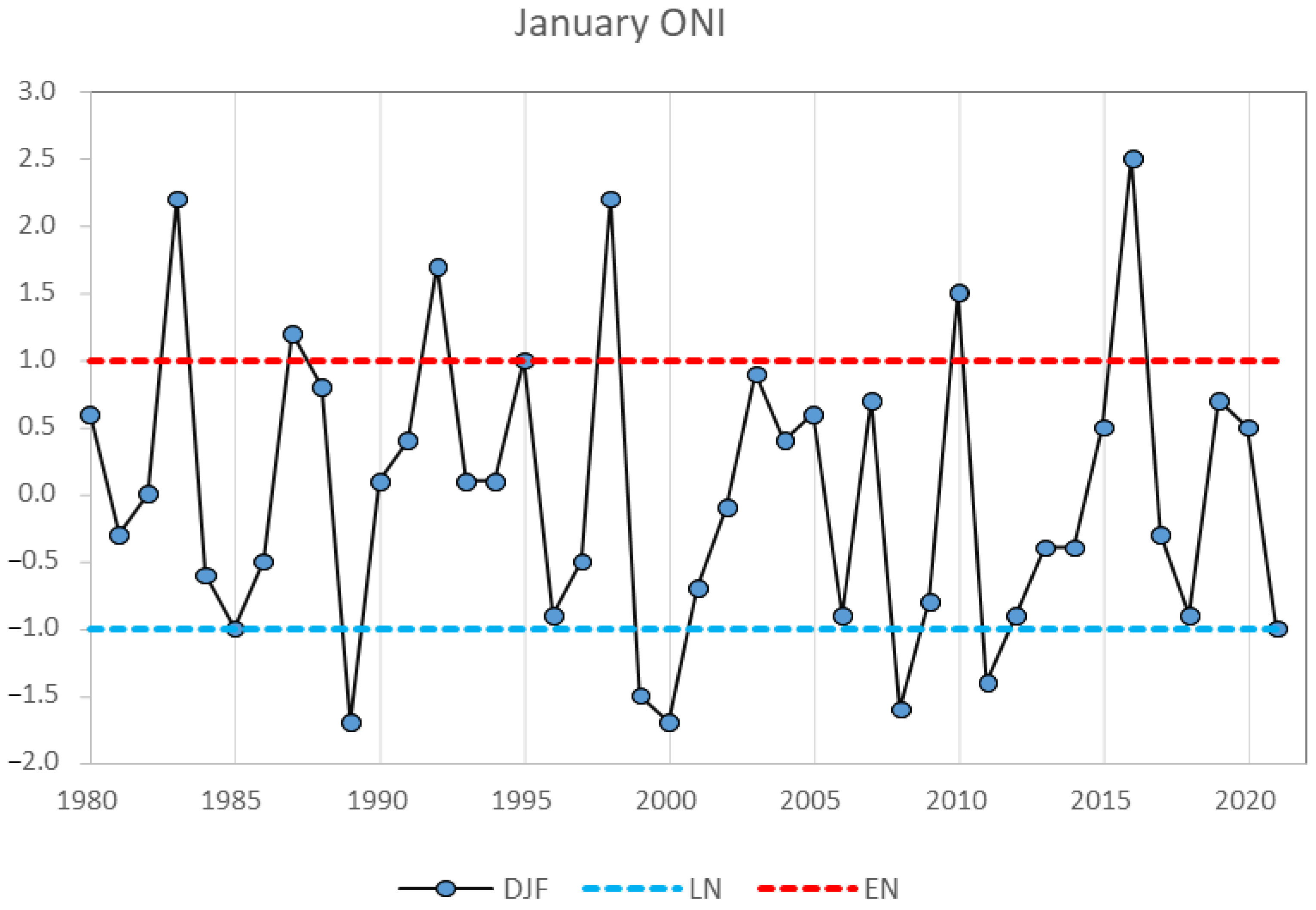
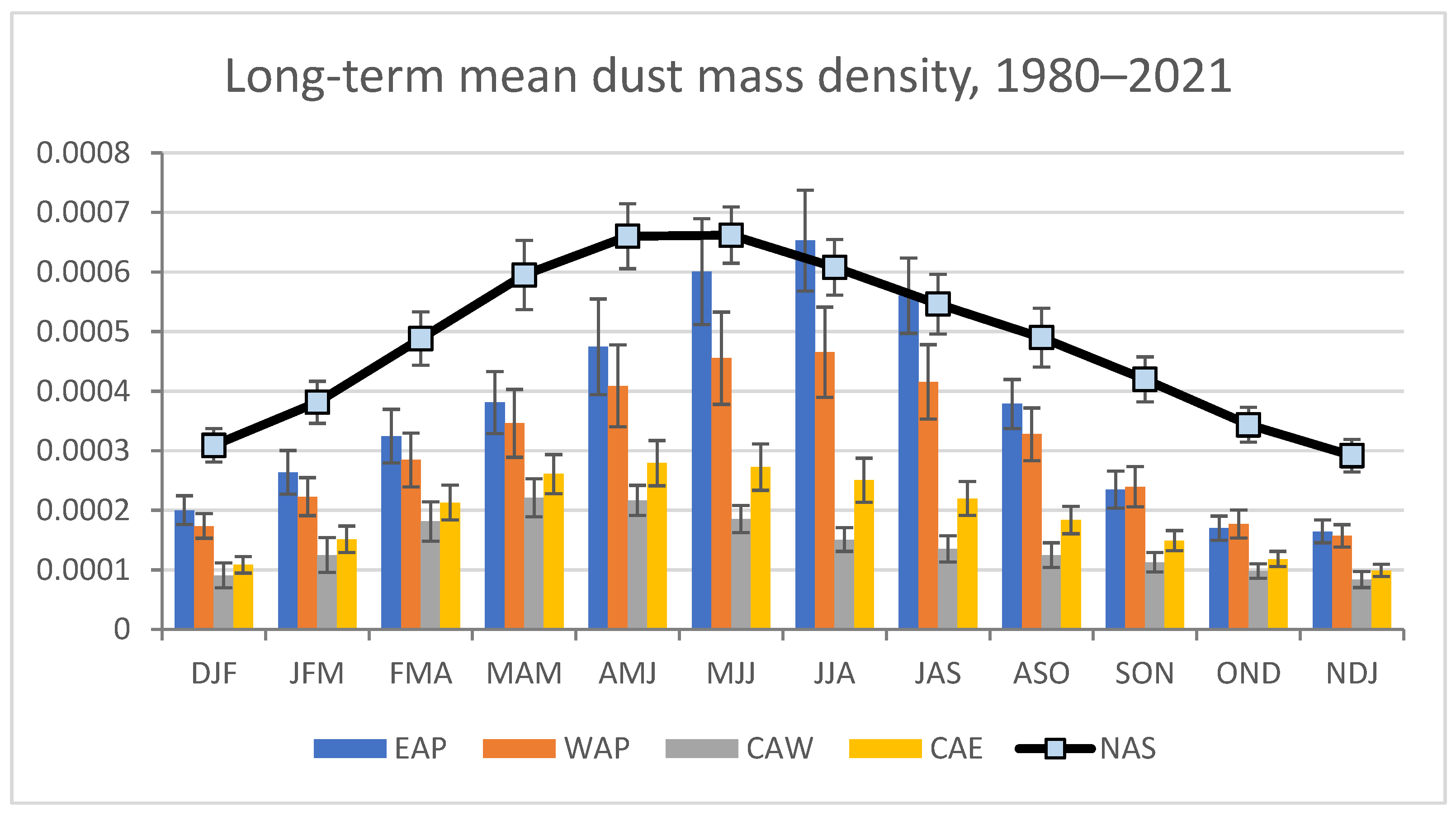



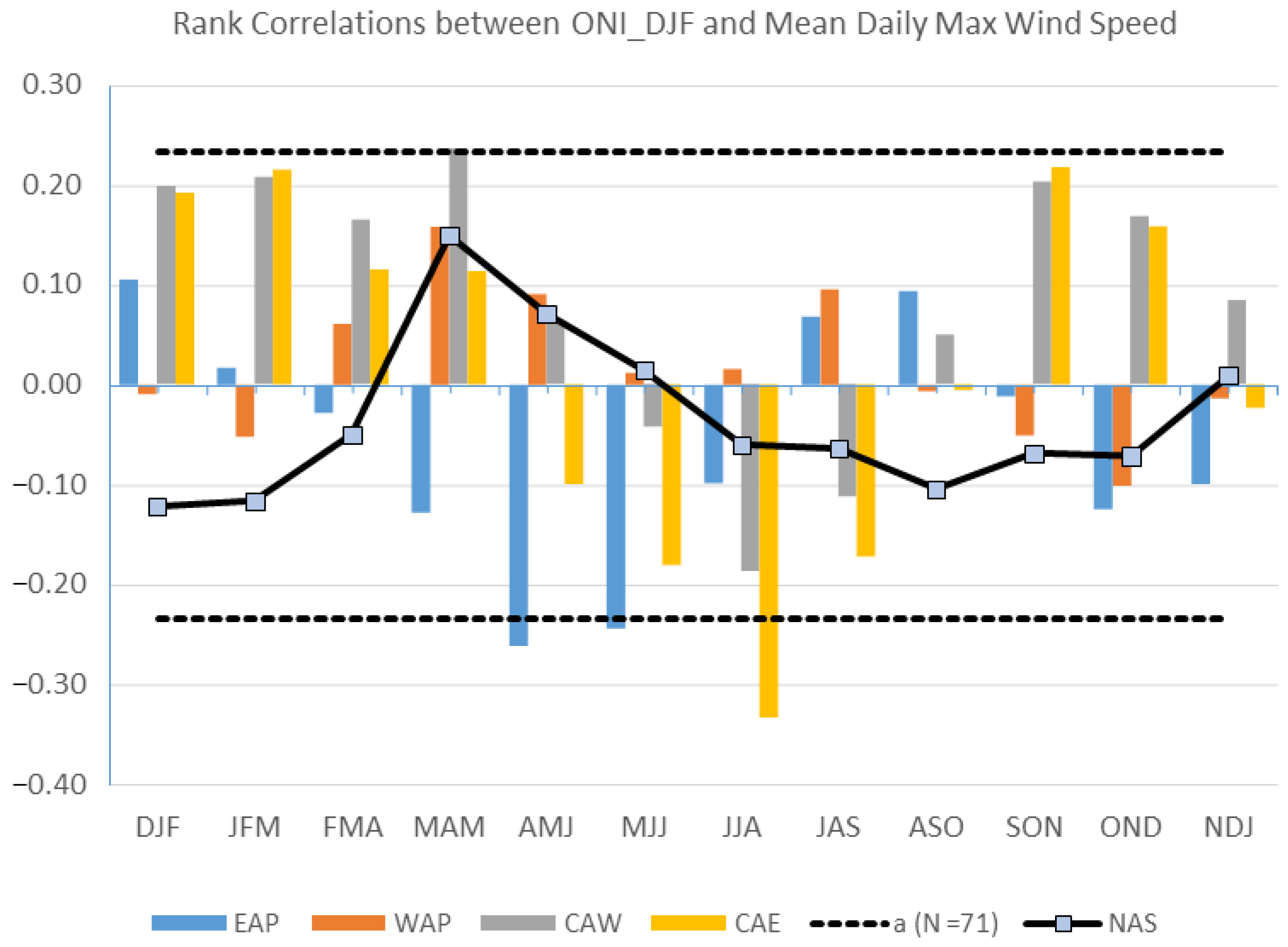
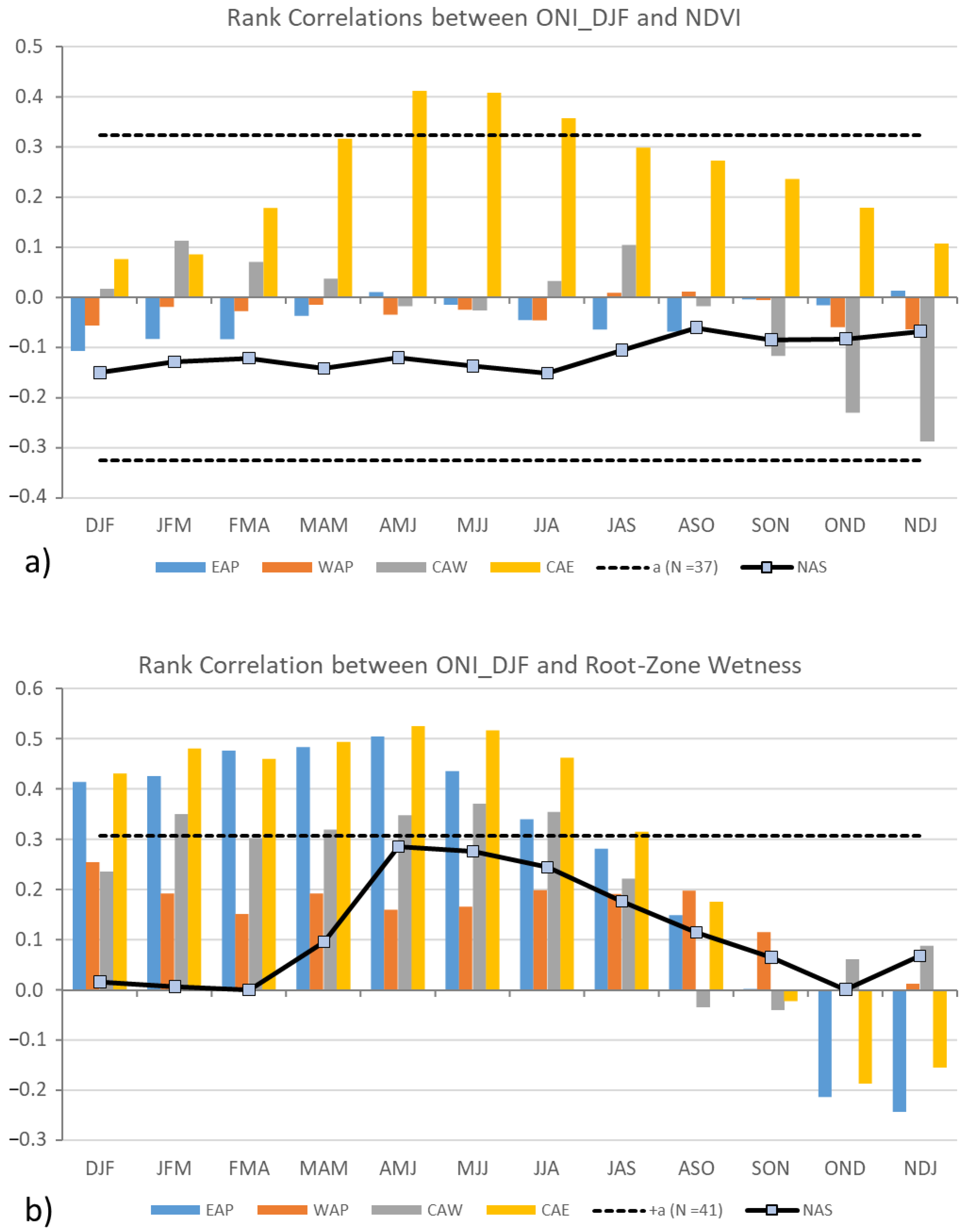
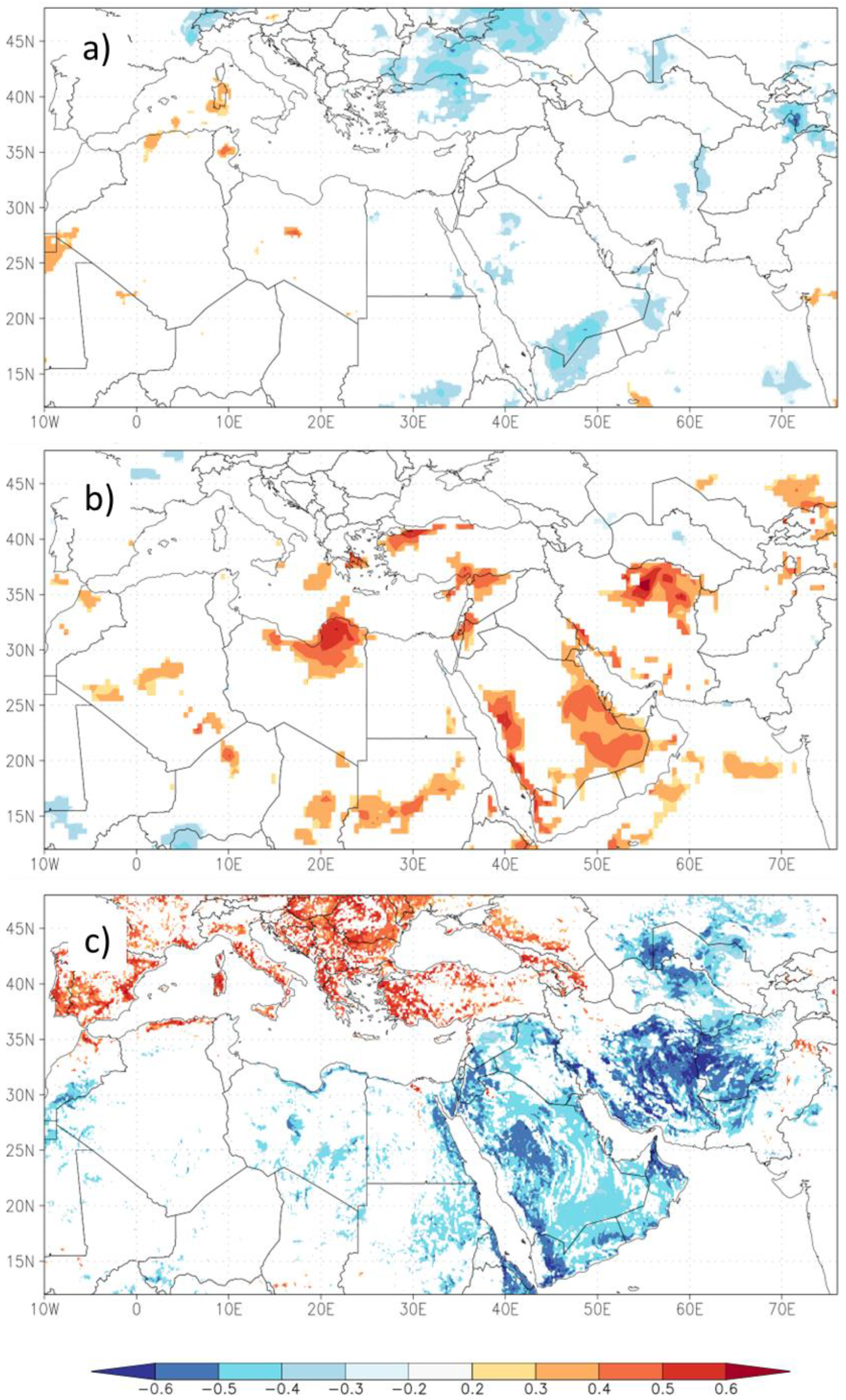
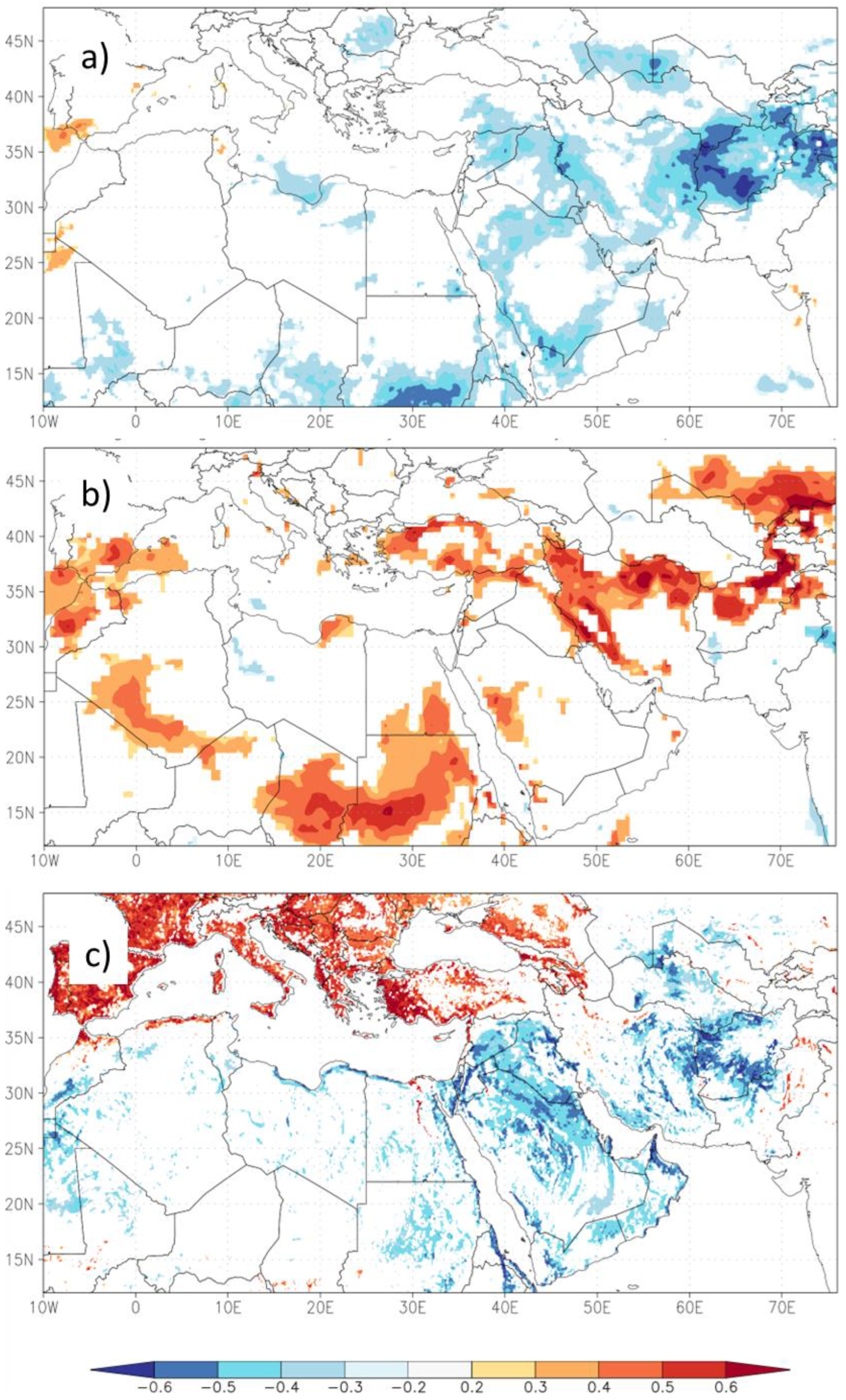
| Factor | Variable Name | Dataset Name | Spatial Resolution | Data Source | Metadata |
|---|---|---|---|---|---|
| Precipitation | Monthly Precipitation (mm/day) | ERA 5 Reanalysis (1950–2021) | 0.25 × 0.25 Lat./Long. | KNMI Climate Explorer | https://www.ecmwf.int/en/forecasts/datasets/reanalysis-datasets/era5 (accessed on 11 August 2022) |
| Humidity | Monthly Mean Surface Column Water Vapor Content (kg m−2) | ERA 5 Reanalysis (1950–2021) | 0.25 × 0.25 Lat./Long. | KNMI Climate Explorer | Same as above |
| Wind | Daily-Mean Near-Surface Wind Speed (m/s) Averaged into Monthly Series | ERA 5 Reanalysis (1950–2021) | 0.5 × 0.5 Lat./Long. | KNMI Climate Explorer | Same as above |
| Vegetation | Monthly Normalized Difference Vegetation Index | NOAA/NCEI CDR NDVI (1981–2019) | 0.1 × 0.1 Lat./Long. | KNMI Climate Explorer | https://www.ncei.noaa.gov/metadata/geoportal/rest/metadata/item/gov.noaa.ncdc:C01558/html (accessed on 20 September 2022) |
| Soil Moisture | Monthly Root Zone Soil Wetness (Unitless) | MERRA-2 (1980–2021) | 0.5 × 0.625 Lat./Long. | NASA GIOVANNI | https://disc.gsfc.nasa.gov/datasets/M2TMNXLND_5.12.4/summary (accessed on 20 September 2022) |
| Months | EAP | WAP | CAW | CAE | NAS |
|---|---|---|---|---|---|
| 1 | 4.2 | 4.3 | 4.5 | 4.1 | 5.0 |
| 2 | 5.9 | 5.9 | 6.8 | 6.2 | 6.3 |
| 3 | 7.8 | 8.0 | 10.4 | 9.4 | 8.5 |
| 4 | 8.4 | 9.3 | 14.3 | 12.1 | 10.5 |
| 5 | 9.7 | 10.9 | 13.6 | 12.4 | 11.8 |
| 6 | 14.2 | 13.1 | 9.7 | 11.8 | 11.9 |
| 7 | 17.0 | 13.1 | 8.9 | 11.3 | 10.6 |
| 8 | 13.3 | 11.7 | 7.6 | 9.6 | 9.0 |
| 9 | 7.9 | 9.1 | 7.0 | 7.8 | 8.7 |
| 10 | 4.6 | 6.0 | 7.1 | 6.5 | 7.7 |
| 11 | 3.5 | 4.6 | 5.6 | 5.0 | 5.4 |
| 12 | 3.5 | 4.0 | 4.4 | 3.8 | 4.7 |
| Dust Season | April–August | April–September | March–July | March–August | March–September |
| rho with ONI_DJF | −0.323 | −0.267 | −0.316 | −0.431 | −0.135 |
| Sig. (N = 42) | 0.037 | 0.087 | 0.042 | 0.004 | 0.395 |
| Surbregions | ANOVA | Kruskal-Wallis | Tukey’s HSD (p-Values) | ||||
|---|---|---|---|---|---|---|---|
| F | Sig. | H | Sig. | ENSO | N | EN | |
| EAP | 9.850 | 0.000 | 16.341 | 0.000 | LN | 0.430 | 0.000 |
| EN | 0.000 | ||||||
| WAP | 8.115 | 0.000 | 15.386 | 0.000 | LN | 0.084 | 0.000 |
| EN | 0.010 | ||||||
| CAW | 5.811 | 0.003 | 9.928 | 0.007 | LN | 0.288 | 0.003 |
| EN | 0.020 | ||||||
| CAE | 17.840 | 0.000 | 24.641 | 0.000 | LN | 0.001 | 0.000 |
| EN | 0.000 | ||||||
| NAS | 0.844 | 0.430 | 1.945 | 0.378 | LN | 0.397 | 0.712 |
| EN | 0.950 | ||||||
| Model | Independ. Variables | Unstand. Coeff. | Std. Error | Stand. Coeff. | t | Sig. | Collinearity Tolerance | VIF | R2 | R2-adj | F | Sig. | Total df |
|---|---|---|---|---|---|---|---|---|---|---|---|---|---|
| EAP_JJA | (Constant) | −0.0005402 | 6.70 × 10−4 | −0.806 | 0.426 | 0.469 | 0.423 | 10.289 | <0.001 | 38 | |||
| EAPws6–8 | 0.0001909 | 8.37 × 10−5 | 0.309 | 2.281 | 0.029 | 0.826 | 1.210 | ||||||
| EAPvi6–8 | −0.0028130 | 8.96 × 10−4 | −0.398 | −3.140 | 0.003 | 0.944 | 1.059 | ||||||
| ONI_DJF | −0.0000241 | 1.04 × 10−5 | −0.307 | −2.320 | 0.026 | 0.868 | 1.152 | ||||||
| WAP_JAS | (Constant) | −0.0004797 | 6.24 × 10−4 | −0.768 | 0.447 | 0.251 | 0.209 | 6.033 | 0.005 | 38 | |||
| WAPvi7–9 | −0.0017204 | 7.04 × 10−4 | −0.361 | −2.444 | 0.020 | 0.952 | 1.051 | ||||||
| WAPws7–9 | 0.0001967 | 1.05 × 10−4 | 0.277 | 1.872 | 0.069 | 0.952 | 1.051 | ||||||
| CAW_ FMA | (Constant) | −0.0001782 | 1.38 × 10−4 | −1.293 | 0.205 | 0.327 | 0.266 | 5.338 | 0.004 | 36 | |||
| ONI_DJF | −0.0000143 | 4.53 × 10−6 | −0.472 | −3.160 | 0.003 | 0.913 | 1.095 | ||||||
| CAWvi2–4 | 0.0004069 | 2.01 × 10−4 | 0.292 | 2.020 | 0.052 | 0.975 | 1.025 | ||||||
| CAWsm2–4 | 0.0004796 | 2.41 × 10−4 | 0.301 | 1.990 | 0.055 | 0.894 | 1.119 | ||||||
| CAE_AMJ | (Constant) | −0.0005601 | 3.12 × 10−4 | −1.796 | 0.081 | 0.496 | 0.452 | 11.153 | <0.001 | 37 | |||
| CAEp1–6 | −0.0000237 | 5.58 × 10−6 | −0.649 | −4.237 | 0.000 | 0.632 | 1.581 | ||||||
| CAEws4–6 | 0.0001243 | 4.63 × 10−5 | 0.362 | 2.686 | 0.011 | 0.817 | 1.224 | ||||||
| CAEsm4–6 | 0.0008894 | 3.90 × 10−4 | 0.348 | 2.279 | 0.029 | 0.636 | 1.573 | ||||||
| NAS_ASO | (Constant) | −0.0000563 | 3.49 × 10−4 | −0.161 | 0.873 | 0.586 | 0.549 | 16.031 | <0.001 | 37 | |||
| NASws8–10 | 0.0002440 | 4.91 × 10−5 | 0.557 | 4.966 | 0.000 | 0.967 | 1.034 | ||||||
| NASsm8–10 | −0.0028163 | 6.96 × 10−4 | −0.611 | −4.047 | 0.000 | 0.535 | 1.870 | ||||||
| NASp8–10 | 0.0001131 | 5.09 × 10−5 | 0.333 | 2.220 | 0.033 | 0.541 | 1.850 |
Publisher’s Note: MDPI stays neutral with regard to jurisdictional claims in published maps and institutional affiliations. |
© 2022 by the authors. Licensee MDPI, Basel, Switzerland. This article is an open access article distributed under the terms and conditions of the Creative Commons Attribution (CC BY) license (https://creativecommons.org/licenses/by/4.0/).
Share and Cite
Yin, Z.-Y.; Maytubby, A.; Liu, X. Variation Patterns of the ENSO’s Effects on Dust Activity in North Africa, Arabian Peninsula, and Central Asia of the Dust Belt. Climate 2022, 10, 150. https://doi.org/10.3390/cli10100150
Yin Z-Y, Maytubby A, Liu X. Variation Patterns of the ENSO’s Effects on Dust Activity in North Africa, Arabian Peninsula, and Central Asia of the Dust Belt. Climate. 2022; 10(10):150. https://doi.org/10.3390/cli10100150
Chicago/Turabian StyleYin, Zhi-Yong, Anne Maytubby, and Xiaodong Liu. 2022. "Variation Patterns of the ENSO’s Effects on Dust Activity in North Africa, Arabian Peninsula, and Central Asia of the Dust Belt" Climate 10, no. 10: 150. https://doi.org/10.3390/cli10100150
APA StyleYin, Z.-Y., Maytubby, A., & Liu, X. (2022). Variation Patterns of the ENSO’s Effects on Dust Activity in North Africa, Arabian Peninsula, and Central Asia of the Dust Belt. Climate, 10(10), 150. https://doi.org/10.3390/cli10100150








